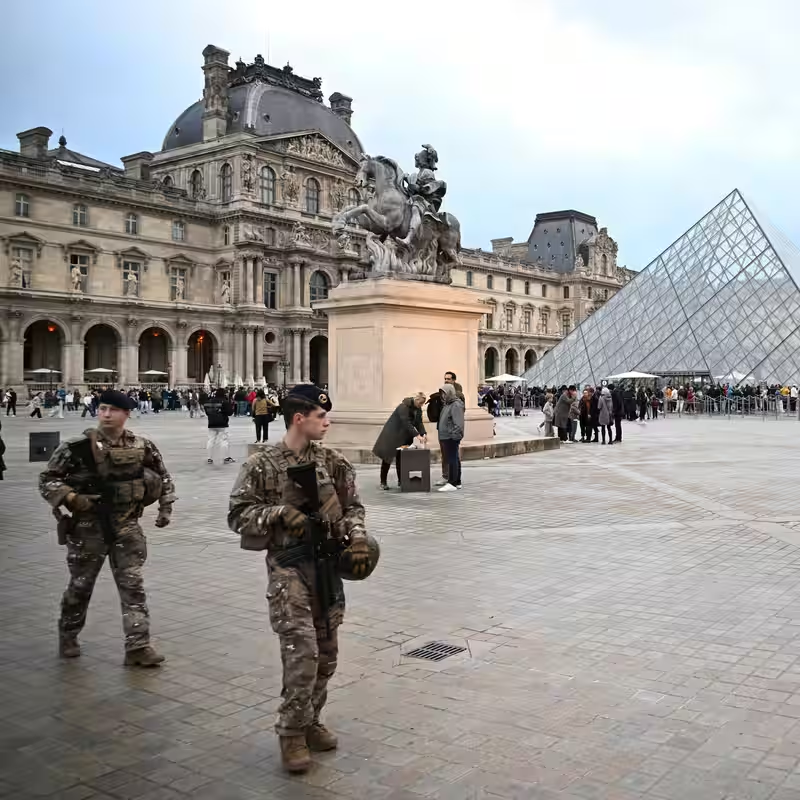Louvre Heist Exposes Shocking Security Gaps
In a brazen daylight robbery that reads like a Hollywood script, four thieves targeted one of the world’s most iconic museums—the Louvre—in central Paris on Sunday morning. The incident has sent shockwaves through France’s cultural and security sectors, raising urgent questions about how such a high-profile institution could be so vulnerable.
How the Robbery Unfolded
At approximately 9:30 a.m., the suspects arrived at the museum’s south side in a truck, parking directly on the sidewalk next to the Louvre’s historic walls. Dressed in high-visibility yellow vests and deploying traffic cones, they convincingly posed as construction workers—a common sight around the sprawling palace-turned-museum.
Using an electric ladder mounted on their vehicle, two of the thieves scaled to the Apollo Gallery, home to an extraordinary collection of royal crown jewels. Armed with power tools, they smashed through a window and gained access to the heavily guarded exhibit.
Inside, unsuspecting visitors continued to wander through more than eight miles of galleries, unaware that a major theft was in progress just above them.
Security Lapses Under Scrutiny
French authorities are now investigating the museum’s alarm and surveillance systems. According to a security expert quoted in The New York Times, the Louvre “wasn’t built with an obsession over security.” This statement has ignited a fierce debate about whether heritage institutions are sacrificing safety for aesthetics or visitor experience.
While the Louvre employs armed soldiers as part of France’s post-terror patrol initiative “Sentinelle,” their presence has historically been concentrated at the museum’s main pyramid entrance—leaving less-trafficked areas like the south façade potentially exposed.
Timeline of the Heist
| Time | Event |
|---|---|
| 9:30 a.m. | Thieves arrive in truck, deploy cones, wear worker vests |
| 9:35–9:45 a.m. | Electric ladder deployed; window breached in Apollo Gallery |
| ~10:00 a.m. | Museum staff alerted; police respond |
| Monday | Armed patrols reinforced; full security review launched |
What Was Stolen?
As of Tuesday, October 21, 2025, French investigators have not disclosed exactly which items were taken from the Apollo Gallery. The collection includes historic French crown jewels, scepters, and ceremonial regalia—many of which are considered irreplaceable national treasures.
Experts warn that if authentic pieces were removed, they may be nearly impossible to sell on the open market, suggesting the theft could be a commissioned job for a private collector—or an inside operation.
Global Implications for Museum Security
The Louvre heist is not an isolated incident. In recent years, museums from Amsterdam to Athens have faced similar breaches. However, the audacity of this attack—carried out in broad daylight in one of the world’s most surveilled cities—has alarmed cultural institutions worldwide.
[INTERNAL_LINK:museum-security] Security consultants now urge a shift from reactive to proactive protocols, including AI-powered surveillance, motion-triggered alarms on display cases, and stricter access controls—even for maintenance zones.
Public and Political Fallout
France’s Interior Minister confirmed that police patrols have been redirected to cover previously overlooked entry points. Meanwhile, opposition lawmakers are calling for an emergency parliamentary session to review national heritage protection policies.
“This isn’t just a theft,” said cultural historian Dr. Élise Moreau. “It’s a national humiliation—and a wake-up call.”




